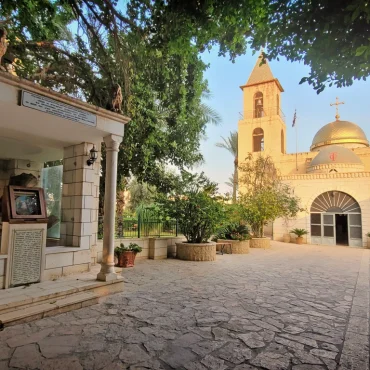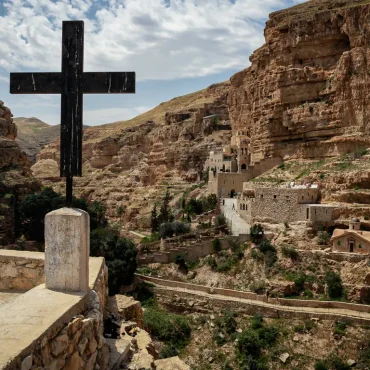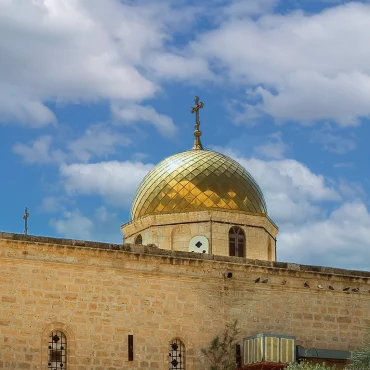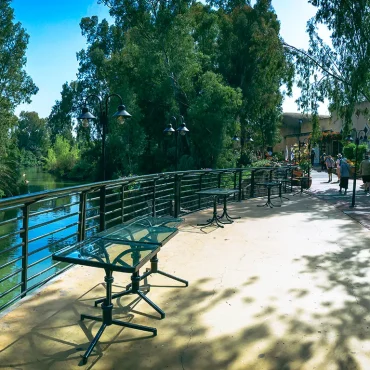The Holy Monastery of Saint George Hozeva
The Holy Monastery of Saint George Hozeva
The Holy Monastery Choziba is one of the oldest Monasteries in Palestine, contemporary to the great monastic centres of Saint Savvas and the Lavra of Saint Theodosius the Cenobiarch in the 6th century. It is built in the desert of Judea, on the road that connects Jericho to Jerusalem. It is the monastery of the Theotokos of Choziba, built over the ruins of the Choziba Lavra. This has always thought to be a holy place, protected by the Theotokos. Joachim and Anna, Theotokos’ parents, during their sacrificial offering at the Temple of Solomon were forced to leave because they were childless. Then Anna remained secluded at her house beseeching God to grant her a child she could offer to the Temple, while Joachim retreated to the desert and fasted for 40 days and nights in the cave saying: “I will neither eat nor drink until the Lord my God visits me and so be it, that my prayer become food and drink”. During prayer, an Angel of the Lord appeared to him and announced the birth of Theotokos. He was at the same cave where Prophet Elijah had found refuge at God’s command, so as to escape Jezebel’s rage, the king of Israel Ahab’s wife.
The monastery is a complex building structure comprised of three floor levels, with a main Church, chapels, the cave of Prophet Elijah, ascetic cells, monks’ cells, guesthouses, complementary areas, yards, basements, etc. The main Church, one-aisled Basilica with a Dome, is dedicated to the Birth of Theotokos, “Theotokos of Choziba”. There are mosaics decorated with the Byzantine two-headed eagle on the north part of the church floor which is dated back on the 12th century.
The monastery reached its peak at the time of the Hegoumen Saint George of Choziba, in the end of the 6th century. It had over 2000 monks then. Saint George Choziba’s tomb is placed in the old 6th century chapel. Prophet Elijah’s cave is found on the third level of the monastery. According to the tradition, Prophet Elijah hid there, being fed by a raven. Also according to the tradition, the monastery was built in an area that was Joachim and Anna’s property. On the roof and walls there are paintings of Christian symbols and hundreds of inscriptions naming homelands and names of the fathers who are buried there. Today’s building was built in 1878 over the ruins of the old Choziba Lavra. The old chapel is dedicated to the five Syrian monks who were the first founders of the monastery. Saint George’s chapel most probably stands today over the place of that first church. The monastery was severely destroyed by the Persian raid and most of the monks were either slaughtered or scattered in the surrounding area. After recurring destructions, the monastery remained active with a few monks until the 12th century when it was refurbished by the Emperor Manuel Komnenos. In the 13th century it was completely deserted until it was once more reconstructed by the Greek monk Kalinikos in 1878.
دير القديس جاورجيوس الخوزيفي
دير القديس جاورجيوس الخوزيفي هو من اقدم أديرة فلسطين، ومعاصر لدير القديس سابا والقديس ثيودوسيوس (عطا الله) اكبر المراكز التنسكيه الرهبانية. دير الخوزيفي المبني في صحراء يهودا على طريق القدس واريحا، هو عبارة عن دير العذراء الخوزيفيه وموجود على انقاض دير لافرا الخوزيفا. يُعتبر هذا الموقع محميّ تحت حمايه والده الاله. بينما كان والدا والدة الاله جدّي المسيح بالجسد يواكيم وحنه يقدمان الذبيحه في هيكل سليمان طُردا لسبب أنهما كانا عاقرين، عندها ذهبت القديسه حنه جلست ببيتها متضرعة بدموع وإنسحاقٍ إلى الرب أن يرزقها إبنا لتنذره للهيكل، واما يواكيم فقد لجأ إلى الصحراء، صائماً أربعين يوماً وليلة في المغاره قائلا: “لن أئتي (اجلس) حتى على ماء، حتى يزورني الرب الهي ولتكن لي الصلاة غداءاً وماءا”. فظهر له ملاك الرب بينما كان يصلي وبشّره انه سوف تولد له أبنة. هنا نتكلم عن المغاره التي لجئ إليها بأمر من الله النبي ايليا (مار الياس)، لكي ينجوَ من غضب ايزابل امرأه ملك اسرائيل آخاب.
الدير الحالي مكون من ثلاثة طوابق ويحتوي على كنيسة مركزية، كنائس صغيرة، مغارة النبي ايليا (مار الياس)، صومعات وقلايات، غرف مُعدة للضيوف وأماكن اخرى كالساحات وطوابق تحت الأرض. الكنيسة الرئيسية مُكرسة لتذكار ولادة والدة الاله “العذراء الخوزيفيه” وهي كنيسه فاسيليكيه الشكل (أي ذات طابع بيزنطي قديم) ولها كليتوس واحد اي الجزء الجانبي للكنيسه مفصول بصف واحدٍ من الاعمدة. في الجزء الشمالي من الارضيه توجد فسيفساء مزخرف عليها النسر البيزنطي ذو الرئسين. هذه الارضيه يعود تاريخها الى القرن الثاني عشر ميلادي.
إزدهر دير الخوزيفي في القرن السادس ميلادي عندما ترأسه القديس جاورجيوس الخوزيفي، حيث في ذلك الحين كان يتجاوز عدد الرهبان ال ٢٠٠٠ راهباً. من الجدير بالذكر أن قبر القديس جاورجيوس الخوريفي موجود في الطابق الثالث. أيضا في الطابق الثالث في الدير توجد مغارة الكنيسة التي تنسب الى النبي الياس، التي حسب التقليد الكنسي إختبأ فيها النبي ايليا وكان يُغذيه الغراب. حسب ما ورد في التقاليد فان الدير بُني في المنطقه التي كانت مُلكٌ لوالدي مريم العذراء، يواكيم وحنه.
نجد أيضاً رسومات بعض الرموز المسيحيه على الجدران ومئات من الكتابات التي تشير الى أسماء وأوطان الآباء الرهبان الراقدين هناك. يعود تاريخ المبنى الحالي الى سنه ١٨٧٨ ميلادي, وهو مبني على انقاض لافرة (لافرا تعني مجموعة صومعات تنسكية صغيرة قديمة) الخوزيفية القديمة. الكنيسة الصغيرة القديمة مُكرسة لتذكار الرهبان الخمسة، أوائل مؤسسي دير الخوزيفي, ومن المحتمل أن كنيسة القديس جاورجيوس الخوريفي الصغيرة الموجودة اليوم تحل مكان هذه الكنيسة الاولى. لقد ازدهر الدير في منتصف القرن السادس وأوائل السابع ميلادي عندما كان رئيس الدير القديس جاورجيوس الخوزيفي، لكن الغزو الفارسي (٦١٤ م.) جلب دمار رهيب في الدير، كما ذبح الفرس اغلبية الرهبان وانتشروا في كل المنطقه. عاش في الدير بعد الدمار عدد قليل من الرهبان حتى القرن الثاني عشر ميلادي، حيث تم ترميمه من الامبراطور البيزنطي عمانوئيل كومنينوس, ليُهجر الدير نهائيا في القرن الثالث عشر ميلادي حتى عام ١٨٧٨ حيث تم ترميمه مجدداً من الراهب المتوحد اليوناني الاصل كالينيكوس.
Prophet Elijah’s cave and Saint Joachim’s prayer place
Over the Catholicon on the east side, there is the cave where Prophet Elijah stayed escaping the rage of the irreverent King Ahab and his wife Jezebel, who had introduced Vaal’s worship in their Kingdom. In that cave the Prophet was fed with bread in the morning and meat in the evening, brought by a raven and drank water from brook Chorath. “Eventually the brook dried up because of the drought. Then God spoke to him: Get up and go to Zerephath in Sidon and live there” (1 Kings 17:7-9). On the north side of the cave there is a marvellous massive icon of Prophet Elijah being fed by the raven.
According to the tradition Joachim stayed at the same cave fasting and praying, beseeching God to give him a child. When one day together with his wife Anna Joachim offered bread in the temple, their offering was declined by the priests because they were considered to be cursed since they were childless, and therefore incapable of bringing forth descendants who would give birth to the Messiah. This incident grieved both of them greatly, and Anna was secluded in her house imploring God to give her a child, while Joachim “didn’t go back to his wife, but abode in the desert and fasted for forty days and nights saying to himself: “I will neither eat nor drink until the Lord my God visits me and so be it, that my prayer become food and drink”. The Lord heard their prayers and both parents decided to offer the child to the Temple. So it happened. The child they begot was Theotokos Maria, who was granted to become the Mother of God. This is how the dedication of the Catholicon of the Monastery to the birth of the Theotokos is justified. On the east side of the monastery there are caves where Saint George of Choziba lived. These caves are called Saint Anna’s skete. According to the tradition, in that place Saint Anna spent the rest of her life after Theotokos’ birth, leading a group of maidens in ascetic striving. This explains the Arab name of the place Der Elbanat which means “monastery of the maidens”.
The holy relic of Saint Anna’s left foot – fragrant with divine scent – was kept in the Skete Church, but it was transferred to the Skete of Saint Anna in Mount Athos when the fathers left Palestine during the war assaults.
مغارة النبي ايليا ومكان صلاة القديس يواكيم جد المسيح
فوق كاثوليكون الدير شرقي القبة هنالك المغارة التي فيها عاش النبي اليليا عندما هرب إلى الصحراء خوفا من الملك أخاب وزوجته إيزابيل, اللذان وُبخا كثيراُ من قِبل النبي إيليا على عبادتهما للأوثان, في هذه المغارة أكل النبي إيليا في الصباح الخبز وفي الليل اللحم الذي كان يحضره غراب وكان يشرب من شلال خورات.
ولسوء الحظ في هذه المنطقة لم يهطل مطر ولا طل على الأرض وحل جفاف شديد وجوع في كل تخوم إسرائيل, وأدّى الجفاف هذا الى جفاف مياه النهر الذي كان ايليا النبي مقيماً بجانبه, حينئذ قال له الرب :”قم واذهب إلى صرفت صيدا وهنالك سوف تجد أرملة ستُقيتك”.”.
في نفس المغارة وحسب التقليد الكنسي بقي والد السيدة العذراء يواكيم صائما ضارعاً الى الرب أن يهبه ابناً, ويقال أن يواكيم جاء مرة إلى هيكل الرب ليقدم تقدمة فرفض الكاهن التقدمة لان مُقدمها (عاقر) فعاد يواكيم إلى داره مُغتماً, كسير القلب, مذلولاً وأكثر من البكاء أمام الله, وشاركته في ذلك زوجته حنة, وهكذا ذهب يواكيم إلى الصحراء وصام أربعين يوماً وأربعين ليلة مردداً بنفسه: “لن انزل ولن اشرب ماء حتى يزورني الرب وتكون صلاتي مأكل ومشرب”. بالفعل حصلت المعجزة وسمع الله صلاة يواكيم, واتفق يواكيم مع حنة زوجته بأن الطفل الذي سوف يولد سوف يكرز للهيكل. وهكذا وُلدت الطفلة مريم التي أصبحت فيما بعد والدة ألاله والتي بالفعل كرست حياتها للهيكل. ومن هنا نرى سبب تكريس الكاثوليكون في الدير في وادي قلط إلى والدة الله.







